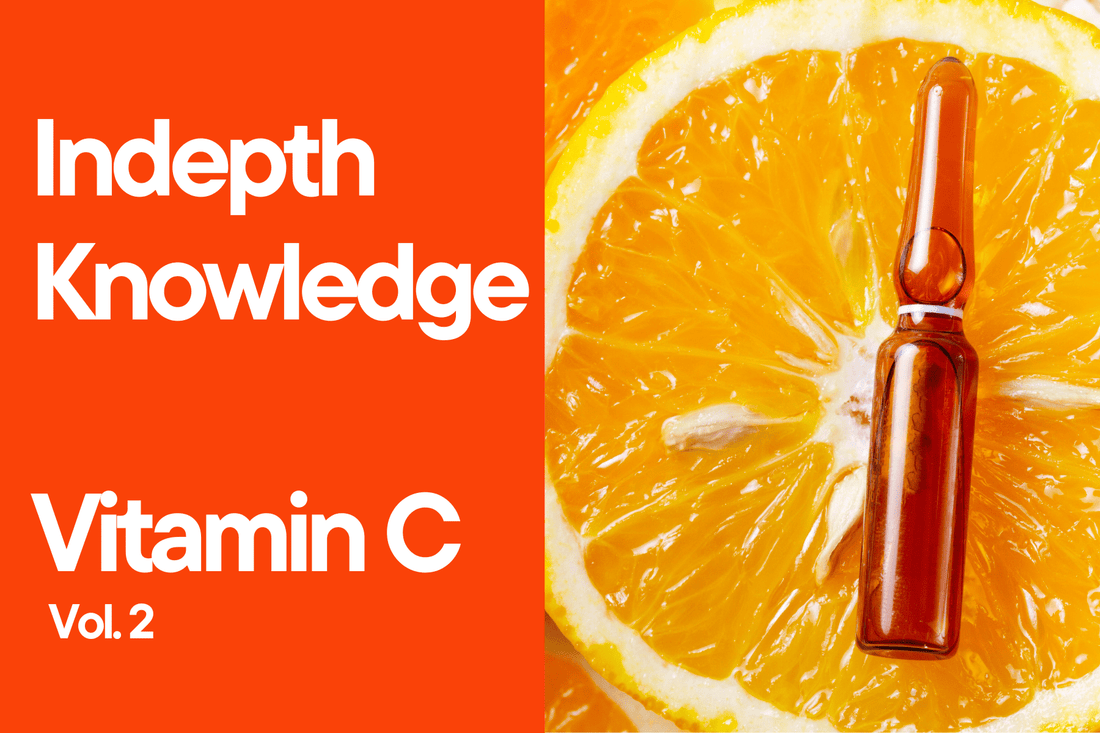If you don't read vol1, 👇👇👇
Indepth Knowledge Vitamin C for Skincare : vol. 1
Let's start again😊,
In cosmetics, vitamin C is written as “l-Ascorbic Acid” instead of “Vitamin C”. This l-ascorbic acid is a pure vitamin C. However, pure Vitamin C is weak to light and easily degraded by oxygen. As a result, natural discoloration takes place as we used cosmetics. When the product color changes from the original transparent color to the yellow color, the product would provide a higher vitamin C absorption rate.

Or course, the discoloration shouldn’t happen so quickly. If the product color changes to bright yellow color within a week, vitamin C in the product may have low stability. A good product would show discoloration after 2-3 months. To solve this discoloration problem, cosmetic brands usually choose a container with dark color. Vitamin C content is put into a brown or sealed container to block the light.

When the color changes beyond a certain level to become bright yellow, it means vitamin C gets fully oxidized so that it doesn’t provide any effect on the skin. So, you better use up the product quickly if it contains a high concentration of Vitamin C. Most people use up vitamin C products within one to two months. To solve many inconveniences and color change issues, cosmetic brands use small containers such as 5 ml.

To make pure Vitamin C more stable to light and oxygen, researchers started adding other ingredients to I-ascorbic acid. These blended vitamin C ingredients are called “Vitamin C derivatives”. We take ‘Ascorbic’ from I-ascorbic acid and the word ‘ascorbyl’ is added to the front or back of the derivative’s name. Examples are as follows, ‘sodium ascorbyl phosphate’, ‘magnesium ascorbyl phosphate’, ‘ascorbyl palmitate’, ‘tetra-isopalmitoyl ascorbic acid’. When you look at the full ingredient list, you sometimes encounter these kinds of derivatives.
However, although such vitamin C derivatives have excellent stability, they can’t penetrate a stratum corneum well, and it has a much lower absorption rate. In the absorption tests, I-ascorbic acid shows a remarkably high absorption rate while other derivatives show a lower absorption rate. Due to this weak absorption rate of vitamin C derivatives, pure l-ascorbic acid is still preferred by many cosmetic brands.

Vitamin E (aka tocopherol) has a complementary chemical relation with Vitamin C. Two vitamins help each other to get back to their original state once one of them becomes oxidized. This "put together" formula makes the effect of vitamin C last longer. Therefore many vitamin C products contain both vitamin C and E together. They also contain other antioxidants such as ferulic acid or coQ10 to maximize the vitamin C effect and enhance product stability

The pH level plays an important role in absorbing vitamin C (pH 3.5). Simply put, If the skin has a high pH level, the absorption rate of Vitamin C drops. So after applying vitamin C product, you better wait a couple of minutes until vitamin C gets fully absorbed, And then apply cream or other skincare products of which the pH is normally 5.5 -7. If not, cream or lotion increases the pH level on the skin to disturb the absorption of vitamin C.
To maximize the vitamin C effect, many vitamin C products have a pH level of around 3.5 to 4 with a concentration of 15% to 20%. That might irritate sensitive skin. In that case, put 1~2 drops of vitamin C ampoule on the lotion or cream and then apply them together. Although this action may reduce the absorption of vitamin C, it will reduce the irritation of vitamin C as well. When you have sensitive or easily irritated skin. your skin needs some time to get used to Vitamin C.

These days, people argue about whether it’s okay to use vitamin C and retinol together. Many publications reveal retinol enhances the vitamin C effect when used together. However, this doesn’t work for sensitive skin. Using retinol and vitamin C together may lead to itching, burning, or uncomfortable feelings. In this case, try retinol alone and give some time to skin to get used to it. Once your skin gt used to retinol and then gradually use vitamin C together. Always, in skincare, little less is better than much more.
Stay Beautiful.
Best Korean Skincare

